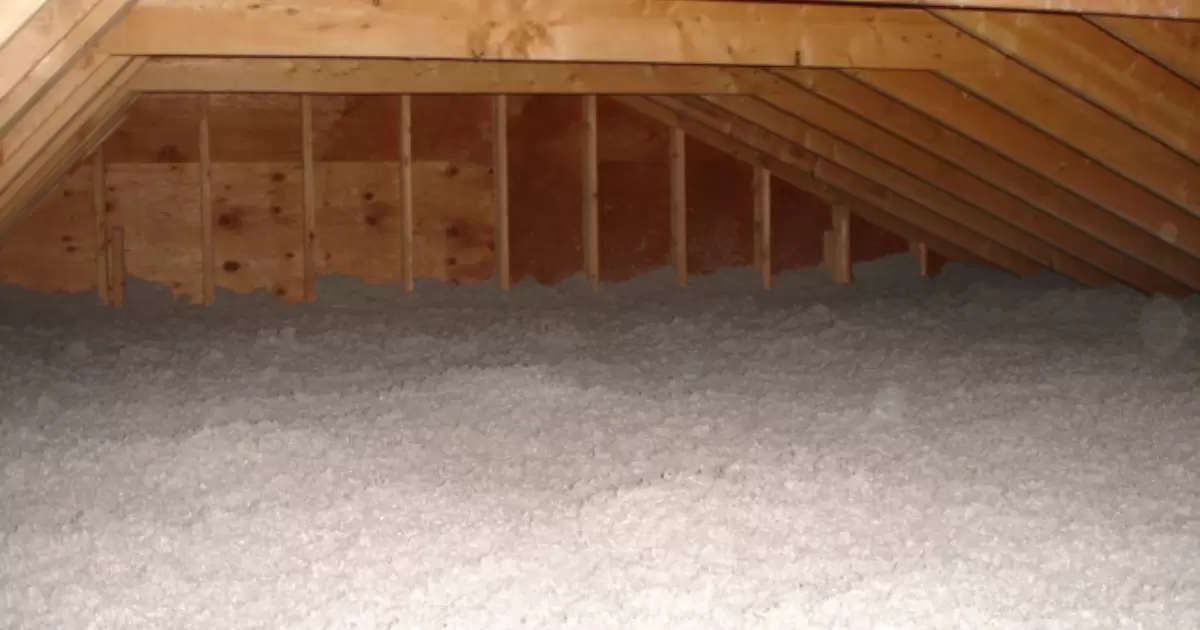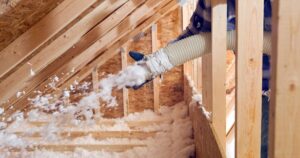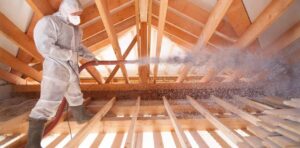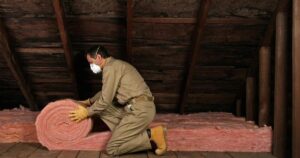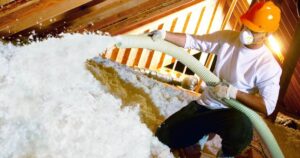Insulation in the context of homes refers to the material used to reduce the transfer of heat between the interior and exterior of a building. It acts as a barrier, limiting the movement of heat and controlling temperature fluctuations within the living space.
In this article, we will explore Insulation in various forms, including fiberglass, cellulose, foam, and more, and is typically installed within walls, floors, ceilings, and attics to enhance energy efficiency.
Attic insulation plays a crucial role in maintaining a comfortable temperature within a home and in conserving energy. There are various types of insulation materials commonly used in attics, such as fiberglass, cellulose, mineral wool, and foam.
Importance of insulation for maintaining indoor temperature
Maintaining a consistent indoor temperature is crucial for comfort and energy efficiency within a home. Proper insulation plays a pivotal role in achieving this by minimizing the heat exchange between the interior and exterior environments.
During the winter, insulated floors help retain the heat generated inside, while in the summer, it prevent excessive heat from infiltrating the house, thus reducing the strain on heating and cooling systems. This not only ensures comfort but also contributes to lower energy bills and a reduced carbon footprint.
Purpose of attic insulation
Attic insulation specifically serves as a critical element in a home’s thermal envelope. Since heat rises, the attic often becomes a focal point for heat loss in a house. Insulating the attic helps to form a barrier, preventing warm air from escaping during the winter and impeding hot air infiltration during the summer.
This significantly contributes to maintaining a more stable indoor temperature throughout the year and reduces the workload on heating and cooling systems. Upgrading or adding more insulation in the attic can have a substantial impact on a home’s overall energy efficiency.
II. Understanding Attic Insulation
This analysis will explore the effectiveness of increasing attic insulation and whether it significantly contributes to better temperature control and energy savings.
A. Types of insulation materials commonly used in attics
Attics can be insulated using various materials, each with its unique properties and installation methods. Common insulation materials include:
1. Fiberglass Insulation: This type comes in rolls or batts and is made of fine glass fibers. It’s popular due to its affordability and relatively easy installation.
2. Cellulose Insulation: Made from recycled paper or cardboard treated with fire-retardant chemicals, it’s blown or sprayed into the attic. Cellulose insulation is eco-friendly and provides good coverage.
3. Spray Foam Insulation: This insulation expands and hardens after application, providing an airtight seal. It’s effective at filling gaps but is more expensive.
4. Mineral Wool: This insulation is made from minerals or rock spun into fibers. It’s fire-resistant and provides good thermal insulation.
B. Factors affecting the effectiveness of attic insulation
Several factors can influence how effectively attic insulation performs:
1. Installation Quality:
Proper installation is crucial for insulation effectiveness. Gaps, compression, or uneven coverage can compromise its efficiency.
2. Moisture Control:
Moisture in the attic can reduce the insulation’s performance. Proper ventilation and addressing any leaks are essential.
3. R-Value:
The R-value measures the insulation’s thermal resistance. Higher R-values offer better insulation, but the effectiveness also depends on the insulation material.
4. Attic Ventilation:
Proper airflow in the attic helps regulate temperature and moisture, enhancing the overall performance of the insulation.
C. Recommended R-value for different regions/climates
The recommended R-value for attic insulation varies based on climate zones:
1. Colder Climates:
Regions with harsh winters require higher R-values. For example, the recommended R-value for attics in northern areas might be around R-49 to R-60.
2. Moderate Climates:
Areas with moderate temperature variations might have recommended R-values around R-38 to R-49 for attics.
3. Warmer Climates:
Regions with milder winters may require R-values around R-30 to R-38 for effective attic insulation.
Understanding the types of insulation, the factors influencing its efficiency, and the recommended R-values for different climates is crucial for ensuring that attic insulation is appropriately chosen and installed to maximize its effectiveness in maintaining indoor comfort and energy efficiency.
Benefits of Adding More Insulation in the Attic
A. Energy efficiency and cost savings
Increased attic insulation significantly contributes to improved energy efficiency within a home. By preventing the escape of heated or cooled air, additional insulation reduces the workload on heating and cooling systems.
This results in lower energy consumption, ultimately leading to cost savings on utility bills. The initial investment in adding more attic insulation often pays for itself through reduced energy expenses over time.
B. Improvement in indoor comfort
Enhancing attic insulation leads to a more consistent indoor temperature. It helps in maintaining a comfortable environment throughout the year by preventing temperature extremes. During the winter, better insulation retains warmth, while in the summer, it keeps the interior cooler. This improved thermal regulation results in a more comfortable living space for occupants.
C. Reduction in carbon footprint
A well-insulated attic aligns with environmentally friendly practices by reducing the overall energy demand of a home. With decreased energy consumption for heating and cooling, there is a direct reduction in greenhouse gas emissions.
By minimizing the reliance on heating and cooling systems, households can contribute to a smaller carbon footprint, promoting sustainability and environmental responsibility.
D. Prevention of moisture and mold issues
Adequate attic insulation plays a crucial role in preventing moisture buildup. By maintaining consistent temperatures, it minimizes the likelihood of condensation in the attic. Moisture control is essential in inhibiting mold growth, which can not only damage the structure of the house but also pose health risks to inhabitants.
Proper insulation helps in keeping the attic dry, reducing the potential for mold and mildew issues.
V. How to Add More Insulation in the Attic
A. DIY methods for adding insulation
1. Assess Current Insulation: Before adding more insulation, assess the current state of insulation in your attic. Check for any damage, gaps, or areas that need improvement.
2. Safety Precautions: Ensure proper safety measures. Use protective gear such as gloves, masks, and clothing that covers your skin. Maintain good ventilation in the attic.
3. Choose Insulation Type: Select the type of insulation suitable for your needs and the attic space. Common options include fiberglass batts, loose-fill cellulose, or spray foam insulation.
4. Preparation: Clear the attic space and create a clean, accessible work area. Seal any air leaks or gaps and address any moisture issues before adding new insulation.
5. Installation: Follow manufacturer guidelines for installation. For fiberglass batts, lay them perpendicular to the existing insulation. For loose-fill insulation, use a blower or hand tools to evenly distribute the material.
6. Safety Check: After installation, ensure proper ventilation and check for any uncovered areas or gaps. Avoid compressing the insulation, as this can reduce its effectiveness.
B. Hiring a professional contractor for insulation installation
1. Assessment: Professional contractors assess the attic to determine the insulation needs, considering the R-value, existing insulation, and any pre-existing issues such as mold or moisture.
2. Expertise and Experience: Contractors bring expertise and experience in handling various insulation types. They know the best practices for installation and can ensure a high-quality, thorough job.
3. Efficiency and Time-saving: Hiring professionals saves time and ensures efficient installation. They have the necessary equipment and expertise to complete the task promptly and effectively.
4. Guarantees and Warranties: Many professional insulation companies offer guarantees or warranties on their work, providing peace of mind regarding the quality of the installation.
5. Compliance and Regulations: Professionals understand local building codes and regulations, ensuring that the insulation installation meets the necessary standards.
Deciding between a DIY approach and hiring a professional contractor for attic insulation depends on individual skills, available time, and the complexity of the job. Both methods have their advantages, and the choice should align with the specific needs and considerations of the homeowner.
FAQ’s
Can you put too much insulation in attic?
Too much of anything is bad, including too much insulation in an attic.
Does insulation in attic make a big difference?
Even an incremental improvement to your insulation can make a huge difference.
Conclusion
Adding more attic insulation not only leads to significant energy savings and cost efficiency but also contributes to a more comfortable, environmentally friendly, and healthier living space by controlling temperature variations and preventing potential issues related to moisture and mold.

